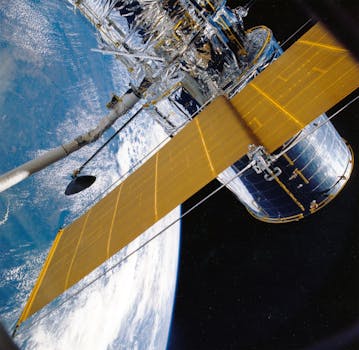From Geostationary to Low Earth Orbit: The Evolution of Satellite Telecommunications in 2023 – Satellite

From Geostationary to Low Earth Orbit: The Evolution of Satellite Telecommunications in 2023 – Satellite
Satellite telecommunications has undergone significant transformations over the years, and 2023 is no exception. The focus keyword satellite telecommunications has been a crucial aspect of the industry, with the shift from geostationary to low earth orbit being a notable development. In this article, we will delve into the evolution of satellite telecommunications, exploring the latest advancements and innovations in the field.
Introduction to Satellite Telecommunications
Satellite telecommunications involves the use of satellites to transmit data, voice, and video signals over long distances. The technology has been around for decades, with the first commercial satellite, Intelsat 1, launched in 1965. Since then, satellite telecommunications has become an essential part of modern communication, enabling global connectivity and facilitating international communication. The focus keyword satellite telecommunications is a vital component of the industry, driving growth and innovation.
Traditionally, satellites have been placed in geostationary orbit, which is approximately 36,000 kilometers above the equator. Geostationary satellites remain stationary relative to a fixed point on the earth’s surface, allowing for continuous coverage of a specific region. However, geostationary satellites have some limitations, such as high latency and limited bandwidth. The evolution of satellite telecommunications has led to the development of new technologies and innovations.
Low Earth Orbit Satellites
In recent years, there has been a shift towards low earth orbit (LEO) satellites, which operate at an altitude of around 160 to 2,000 kilometers. LEO satellites have several advantages over geostationary satellites, including lower latency, higher bandwidth, and improved coverage. LEO satellites are also less expensive to launch and maintain, making them an attractive option for companies looking to enter the satellite telecommunications market. The focus keyword satellite telecommunications is closely related to the development of LEO satellites.
One of the key benefits of LEO satellites is their ability to provide global coverage with a smaller number of satellites. This is because LEO satellites can cover a larger area due to their lower altitude and faster movement. Additionally, LEO satellites can be used to provide internet connectivity to remote and underserved areas, where traditional telecommunications infrastructure is lacking. The evolution of satellite telecommunications has enabled the development of new applications and services.
Advances in Satellite Technology
The evolution of satellite telecommunications has been driven by advances in technology, including improvements in satellite design, materials, and propulsion systems. One of the most significant developments is the use of phased arrays, which enable satellites to steer beams electronically, allowing for more efficient use of bandwidth and power. The focus keyword satellite telecommunications is closely related to the development of new technologies and innovations.
Another area of advancement is in the field of propulsion systems. Traditional satellites use chemical propulsion systems, which are heavy and inefficient. Newer satellites are using electric propulsion systems, which are more efficient and provide greater maneuverability. This has enabled satellites to maintain their position and altitude more accurately, reducing the need for costly and complex station-keeping maneuvers. The evolution of satellite telecommunications has enabled the development of new propulsion systems and technologies.
The use of 3D printing and other advanced manufacturing techniques has also revolutionized the production of satellites. Satellites can now be built more quickly and at a lower cost, making them more accessible to a wider range of companies and organizations. The focus keyword satellite telecommunications is a vital component of the industry, driving growth and innovation.
Conclusion
In conclusion, the evolution of satellite telecommunications has come a long way, from geostationary to low earth orbit. The latest advancements and innovations in satellite technology have enabled the development of new applications and services, including global internet connectivity and remote sensing. As the demand for satellite telecommunications continues to grow, we can expect to see further innovations and advancements in the field. The focus keyword satellite telecommunications will remain a crucial aspect of the industry, driving growth and innovation in the years to come.
The shift towards LEO satellites and the development of new technologies and innovations will continue to shape the future of satellite telecommunications. With the increasing demand for global connectivity and the need for more efficient and effective communication systems, the evolution of satellite telecommunications will remain a vital aspect of modern communication. The focus keyword satellite telecommunications is a vital component of the industry, driving growth and innovation.
The evolution of satellite telecommunications has enabled the development of new applications and services, including remote sensing, navigation, and communication. The use of satellite telecommunications has become an essential part of modern life, enabling global connectivity and facilitating international communication. The focus keyword satellite telecommunications is a crucial aspect of the industry, driving growth and innovation in the years to come.
In the future, we can expect to see further innovations and advancements in satellite technology, including the development of new propulsion systems, materials, and manufacturing techniques. The use of artificial intelligence and machine learning will also play a crucial role in the evolution of satellite telecommunications, enabling more efficient and effective communication systems. The focus keyword satellite telecommunications will remain a vital component of the industry, driving growth and innovation.




